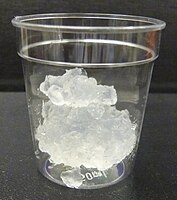
Photo from wikipedia
Abstract An effective cellulose-based antiscalant, namely, carboxymethyl cellulose-graft-poly(acrylic acid) (CMC-g-PAA) was synthesized via the graft copolymerization of carboxymethyl cellulose (CMC) and acrylic acid. The addition of CMC-g-PAAs can evidently delay… Click to show full abstract
Abstract An effective cellulose-based antiscalant, namely, carboxymethyl cellulose-graft-poly(acrylic acid) (CMC-g-PAA) was synthesized via the graft copolymerization of carboxymethyl cellulose (CMC) and acrylic acid. The addition of CMC-g-PAAs can evidently delay the formation of the CaSO4 scale, effectively mitigate reverse osmosis (RO) membrane scaling and flux decline, and increase the induction time of crystallization due to the grafted carboxyl groups efficiently interacting with scale-forming substances. The inhibition performance of CMC-g-PAA in the static test was mostly consistent with that in the RO test. Combining the results of the RO and static tests and the relevant characterizations by scanning electron microscopy, optical microscope, x-ray diffraction, and conductivity measurements, the scale-inhibition mechanisms of CMC-g-PAA are mainly ascribed to enhanced chelation, dispersion, and threshold effects. Moreover, the two structural factors of CMC-g-PAAs, grafting ratio and grafted-chain distribution, play important roles in their inhibition effects. Appropriate grafting ratio was necessary to obtain high-performance CMC-g-PAA. With a similar grafting ratio, a higher average number of PAA grafted chains can lead to better inhibition performance because of more active inhibition sites contained. However, the grafting ratio has more contributions than grafted-chain distribution. This study provides a better understanding of the structure–activity relationship of the grafting-modified polymeric inhibitor and fundamental guidance for the exploitation and design of novel and efficient scale inhibitors.
Journal Title: Journal of Membrane Science
Year Published: 2020
Link to full text (if available)
Share on Social Media: Sign Up to like & get
recommendations!